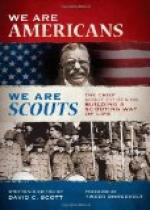The question of getting meat was never thought of as one could get a plenty of that anywhere on the journey, and the streams were teaming with the most delicious fish.
The evening before we were to set out in the morning the Capt said, “Which way shall we go?”
I said, “Although it is getting late, and we may have some cold weather to contend with I think our best and most direct route will be by what is called the Panhandle route. There will be no rivers to cross, and there is a plenty of grass for the horses, and also there is nice drinking water in abundance all the way for ourselves as well as the hordes, and there will be days when we will be in sight of Deer and Antelope from morning until night.”
There were a few scattering settlements along the trail. The place which is now the city of Childress being the largest, and also the last settlement we passed through, and the last sign of civilization we saw until we struck Bent’s Fort which was on the Arkansas river below what is now the city of Pueblo in the state of Colorado which was at that time a territory just a little north of what is now the city of Amarillo.
We killed our first Buffalo on that trip.
It is surprising to the people who saw that country at that early day when they travel through it now and see what civilization has done. There is Amarillo, which has several thousand inhabitants today, and at the time I am speaking of there was not a house or sign of a living person there, and a number of other places I could mention that are thriving cities now were at that time inhabited by wild animals alone.
In the year of forty-eight when Kit Carson and I went across the Rocky mountains with Col. Freemont, we camped three days where the city of Pueblo, Colorado, now stands.
Our camp was under a very large pine tree, one of the largest in that country.
Five years ago I visited the city of Pueblo again, the first time I had been there since that time.
I imagined I could go right to the spot where our camp was located, and the morning after I arrived there I took a walk on the main business street, which I thought was about where our camp had stood. But search as long as I might, there was nothing to show me a sign of the old landmarks.
I went to the river, thinking that must look the same, but no, even the channel of that had been changed.
Amazed at the change civilization had wrought in obliterating everything that I had thought would be a guide to the old places I sought, I spoke to a police officer and asked him if be could tell me whether a very large tree had stood in that neighborhood or not before that street was laid out.
He answered, “Yes, that tree stood right under that brick building,” and he pointed to a large building near where we stood, and he continued. “As long as the tree stood there, it was called ’Freemont’s camping ground.’”




